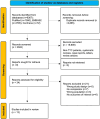Survival benefit of secondary prevention medical therapy in takotsubo cardiomyopathy: a Bayesian network meta-analysis
- PMID: 40357262
- PMCID: PMC12066946
- DOI: 10.1093/ehjopen/oeaf040
Survival benefit of secondary prevention medical therapy in takotsubo cardiomyopathy: a Bayesian network meta-analysis
Abstract
Aims: Takotsubo cardiomyopathy (TTC) is a form of transient left ventricular systolic dysfunction without evidence of complicated coronary artery disease. Efficacy of medical therapy in secondary prevention of all-cause mortality is not well established. We performed a systematic review and network meta-analysis to compare survival benefit of secondary prevention medical therapy in patients with TTC.
Methods and results: PubMed, Embase, and Cochrane were searched up to 6 January 2024. Eligible studies included multivariable-adjusted or propensity-matched studies of patients receiving medical therapy with beta-blockers, angiotensin-converting enzyme inhibitors (ACE) or angiotensin receptor blockers (ARBs), aspirin, and statins after an index presentation with TTC. The primary outcome was all-cause mortality at any time point. Secondary outcome was TTC recurrence. Random-effect hierarchical Bayesian meta-analysis was performed. We identified 13 observational studies. Takotsubo cardiomyopathy mortality was reported in 435 (4.7%) out of 9237 patients, across a median follow-up of 2.18 years. Mean age was 69.7 ± 12.5 years, and 7906 patients (90.7%) were females. Beta-blockers were associated with a statistically significant reduction in mortality compared to control [hazard ratio (HR) 0.65, 95% confidence interval (CI) (0.55-0.77)]. ACE inhibitors/ARBs showed a nonsignificant trend towards mortality reduction [HR 0.76, 95% CI (0.54-1.07)]. Statins [HR 0.96, 95% CI (0.77-1.19)] and aspirin [HR 0.87, 95% CI (0.55-1.38)] showed no significant mortality benefit. Bayesian probability ranks favoured beta-blockers as the most effective treatment for TTC mortality prevention.
Conclusion: This review highlights the modest efficacy of secondary prevention medications in the management of TTC, as ACE or ARBs, beta-blockers, aspirin, and statins failed to demonstrate comparative mortality benefit. Randomized controlled trials are needed to confirm efficacy of pharmacotherapy in this vulnerable patient cohort.
Keywords: Acute coronary syndrome; Heart failure; Pharmacotherapy; Takotsubo cardiomyopathy.
© The Author(s) 2025. Published by Oxford University Press on behalf of the European Society of Cardiology.
Conflict of interest statement
Conflict of interest: None declared.
Figures




References
-
- Bossone E, Savarese G, Ferrara F, Citro R, Mosca S, Musella F, Limongelli G, Manfredini R, Cittadini A, Perrone Filardi P. Takotsubo cardiomyopathy: overview. Heart Fail Clin 2013;9:249–266. - PubMed
-
- Akashi YJ, Nakazawa K, Sakakibara M, Miyake F, Koike H, Sasaka K. The clinical features of takotsubo cardiomyopathy. QJM 2003;96:563–573. - PubMed
-
- Sharkey SW, Lesser JR, Maron MS, Maron BJ. Why not just call it tako-tsubo cardiomyopathy: a discussion of nomenclature. J Am Coll Cardiol 2011;57:1496–1497. - PubMed
-
- Ghadri J-R, Wittstein IS, Prasad A, Sharkey S, Dote K, Akashi YJ, Cammann VL, Crea F, Galiuto L, Desmet W, Yoshida T, Manfredini R, Eitel I, Kosuge M, Nef HM, Deshmukh A, Lerman A, Bossone E, Citro R, Ueyama T, Corrado D, Kurisu S, Ruschitzka F, Winchester D, Lyon AR, Omerovic E, Bax JJ, Meimoun P, Tarantini G, Rihal C, Y.-Hassan S, Migliore F, Horowitz JD, Shimokawa H, Lüscher TF, Templin C. International expert consensus document on takotsubo syndrome (part I): clinical characteristics, diagnostic criteria, and pathophysiology. Eur Heart J 2018;39:2032–2046. - PMC - PubMed
LinkOut - more resources
Full Text Sources
Miscellaneous

